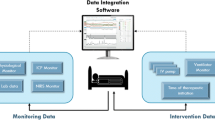Abstract
Object The operating room is rich in digital data that must be rapidly gathered and integrated by caregivers, potentially distracting them from direct patient care. We hypothesized that current desktop computers could integrate enough electronically accessible perioperative data to present a unified, contextually appropriate snapshot of the patient to the operating room team without requiring any user intervention.
Materials and methods We implemented a system that integrates data from surgical and anesthesia devices and information systems, as well as an active radiofrequency identification location tracking system, to create a comprehensive, unified, time-synchronized database of all digital data produced by these systems. Next, a human factors engineering approach was used to identify selected data to show on a large format display during surgery.
Results A prototype system has been in daily use in a clinical operating room since August 2005. The system functions automatically without any user input, as the display system self-configures based on cues from the primary data. The system is vendor agnostic with respect to input data sources and display options.
Conclusion Automatic integration and display of team-synchronizing data from medical devices and hospital information systems is now possible using software that runs on a personal computer.
Similar content being viewed by others
References
Sandberg WS, Daily B, Egan M, Stahl JE, Goldman JM, Wiklund RA and Rattner D (2005). Deliberate perioperative systems design improves operating room throughput. Anesthesiology 103: 406–418
Hanss R, Buttgereit B, Tonner PH, Bein B, Schleppers A, Steinfath M, Scholz J and Bauer M (2005). Overlapping induction of anesthesia: an analysis of benefits and costs. Anesthesiology 103: 391–400
Torkki PM, Marjamaa RA, Torkki MI, Kallio PE and Kirvela OA (2005). Use of anesthesia induction rooms can increase the number of urgent orthopedic cases completed within 7 hours. Anesthesiology 103: 401–405
Cendan JC, Good M (2006) Interdisciplinary work flow assessment and redesign decreases operating room turnover time and allows for additional caseload. Arch Surg 141:65–69; discussion 70
Friedman DM, Sokal SM, Chang Y and Berger DL (2006). Increasing operating room efficiency through parallel processing. Ann Surg 243: 10–14
Harders M, Malangoni MA, Weight S and Sidhu T (2006). Improving operating room efficiency through process redesign. Surgery 140: 509–516
Sokolovic E, Biro P, Wyss P, Werthemann C, Haller U, Spahn D and Szucs T (2002). Impact of the reduction of anaesthesia turnover time on operating room efficiency. Eur J Anaesthesiol 19: 560–563
Guerlain S, Adams RB, Turrentine FB, Shin T, Guo H, Collins SR and Calland JF (2005). Assessing team performance in the operating room: development and use of a “black-box” recorder and other tools for the intraoperative environment. J Am Coll Surg 200: 29–37
Healey AN, Sevdalis N and Vincent CA (2006). Measuring intra- operative interference from distraction and interruption observed in the operating theatre. Ergonomics 49: 589–604
Lingard L, Espin S, Whyte S, Regehr G, Baker GR, Reznick R, Bohnen J, Orser B, Doran D and Grober E (2004). Communication failures in the operating room: an observational classification of recurrent types and effects. Qual Saf Health Care 13: 330–334
Moss J and Xiao Y (2004). Improving operating room coordination: communication pattern assessment. J Nurs Adm 34: 93–100
Ren Y, Kiesler S, Fussell S, Scupelli P (2007) Trajectories. In: Multiple group coordination: field study of hospital operating suites 40th Hawaii international conference on system sciences. Honolulu, HI
Sandberg WS, Ganous TJ and Steiner C (2003). Setting a research agenda for perioperative systems design. Semin Laparosc Surg 10: 57–70
Marvik R, Lango T and Yavuz Y (2004). An experimental operating room project for advanced laparoscopic surgery. Semin Laparosc Surg 11: 211–216
Sandberg WS, Hakkinen M, Egan M, Curran PK, Fairbrother P, Choquette K, Daily B, Sarkka JP and Rattner D (2005). Automatic detection and notification of “wrong patient-wrong location” errors in the operating room. Surg Innov 12: 253–260
Marjamaa RA, Torkki PM, Torkki MI and Kirvela OA (2006). Time accuracy of a radio frequency identification patient tracking system for recording operating room timestamps. Anesth Analg 102: 1183–1186
Dain S (2002). Normal accidents: human error and medical equipment design. Heart Surg Forum 5: 254–257
Krol M and Reich DL (2000). Development of a decision support system to assist anesthesiologists in operating room. J Med Syst 24: 141–146
Navabi MJ, Watt RC, Hameroff ST and Mylrea KC (1991). Integrated monitoring can detect critical events and improve alarm accuracy. J Clin Eng 16: 295–306
Oberli C, Urzua J, Saez C, Guarini M, Ciprianio A, Garayar B, Lema G, Canessa R, Sacco C and Irarrazaval M (1999). An expert system for monitor alarm integration. J Clin Monit Comput 15: 29–35
Xiao Y, Hu P, Hu H, Ho D, Dexter F, Mackenzie CF, Seagull FJ, Dutton RP (2005) An algorithm for processing vital sign monitoring data to remotely identify operating room occupancy in real-time. Anesth Analg 101:823–829, table of contents
Meyer MA, Sokal SM, Sandberg W, Chang Y, Daily B and Berger DL (2006). INCOMING!—A Web Tracking Application for PACU and post-surgical patients. J Surg Res 132: 153–158
Spring SF, Sandberg WS, Anupama S, Walsh JL, Driscoll WD and Raines DE (2007). Automated documentation error detection and notification improves anesthesia billing performance. Anesthesiology 106: 157–163
Author information
Authors and Affiliations
Corresponding author
Electronic Supplementary material
Below is the link to the Electronic Supplementary Material.
Rights and permissions
About this article
Cite this article
Meyer, M.A., Levine, W.C., Egan, M.T. et al. A computerized perioperative data integration and display system. Int J CARS 2, 191–202 (2007). https://doi.org/10.1007/s11548-007-0126-0
Received:
Accepted:
Published:
Issue Date:
DOI: https://doi.org/10.1007/s11548-007-0126-0




